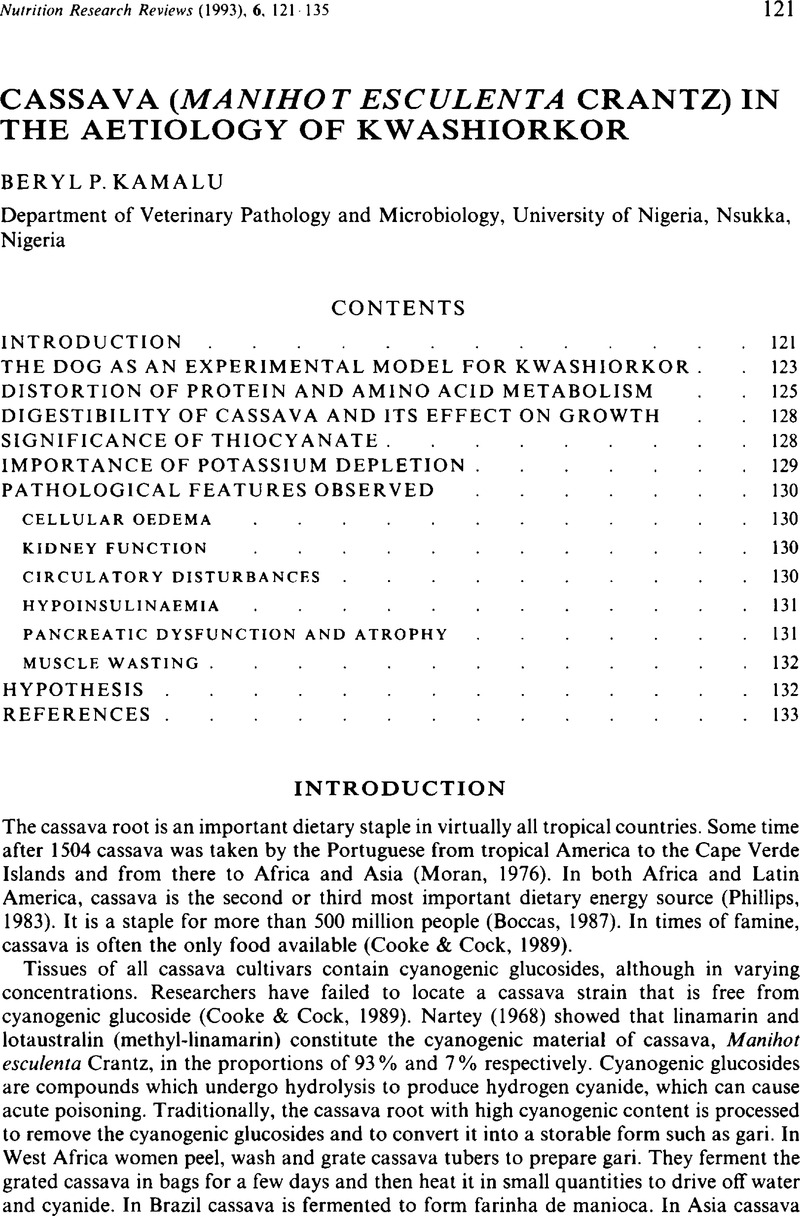Crossref Citations
This article has been cited by the following publications. This list is generated based on data provided by Crossref.
Kamalu, Beryl P.
1995.
The adverse effects of long-term cassava (Manihot esculentaCrantz) consumption.
International Journal of Food Sciences and Nutrition,
Vol. 46,
Issue. 1,
p.
65.
Scherbaum, Veronika
and
Fürst, Peter
2000.
New concepts on nutritional management of severe malnutrition: the role of protein.
Current Opinion in Clinical Nutrition and Metabolic Care,
Vol. 3,
Issue. 1,
p.
31.
Odigwe, Chibuzo Clement
Smedslund, Geir
Ejemot-Nwadiaro, Regina I
Anyanechi, Chiedozie C
Krawinkel, Michael Bernhardt
and
Odigwe, Chibuzo Clement
2009.
Cochrane Database of Systematic Reviews.
Odigwe, Chibuzo C
Smedslund, Geir
Ejemot-Nwadiaro, Regina I
Anyanechi, Chiedozie C
and
Krawinkel, Michael B
2010.
Supplementary vitamin E, selenium, cysteine and riboflavin for preventing kwashiorkor in preschool children in developing countries.
Cochrane Database of Systematic Reviews,
Matusiewicz, Magdalena
Kosieradzka, Iwona
Zuk, Magdalena
and
Szopa, Jan
2015.
Effect of Dose and Administration Period of Seed Cake of Genetically Modified and Non-Modified Flax on Selected Antioxidative Activities in Rats.
International Journal of Molecular Sciences,
Vol. 16,
Issue. 12,
p.
14259.
Lim, T. K.
2016.
Edible Medicinal and Non-Medicinal Plants.
p.
308.
NACONSIE, Maliwan
and
ZHANG, Peng
2016.
Transgenic technologies in cassava for nutritional improvement and viral disease resistance: a key strategy for food security in Africa.
Frontiers of Agricultural Science and Engineering,
Vol. 3,
Issue. 4,
p.
285.
Natesh N, Hemmige
SK, Asiedu
and
L, Abbey
2017.
An overview of nutritional and anti nutritional factors in green leafy vegetables.
Horticulture International Journal ,
Vol. 1,
Issue. 2,
Bertolo, Robert F
2021.
The multifactorial consequences of sulfur amino acid deficiency.
The American Journal of Clinical Nutrition,
Vol. 114,
Issue. 3,
p.
839.
Fitzpatrick, Merry C
Kurpad, Anura V
Duggan, Christopher P
Ghosh, Shibani
and
Maxwell, Daniel G
2021.
Dietary intake of sulfur amino acids and risk of kwashiorkor malnutrition in eastern Democratic Republic of the Congo.
The American Journal of Clinical Nutrition,
Vol. 114,
Issue. 3,
p.
925.
Sarkar, Tanmay
Salauddin, Molla
Roy, Sarita
Chakraborty, Runu
Rebezov, Maksim
Shariati, Mohammad Ali
Thiruvengadam, Muthu
and
Rengasamy, Kannan R. R
2023.
Underutilized green leafy vegetables: frontier in fortified food development and nutrition.
Critical Reviews in Food Science and Nutrition,
Vol. 63,
Issue. 33,
p.
11679.





